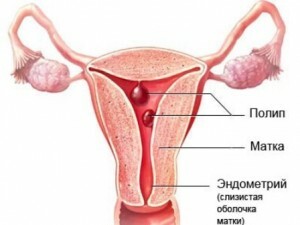Pathological development of the mucous membrane of the uterus in 20% of cases leads to the appearance on it of glandular, fibrous, mixed or adenomatous neoplasms. These are polyps that force for prompt intervention.
Today's medicine is able to get rid of them without a large traumatization of tissues, a minimal risk of complications, a long rehabilitation period. But still many people want to know in advance the details of such a surgical procedure, as removal of the endometrial polyps( hysteroscopy), the consequences of the operation.
Why with hysteroscopy, the risk of complications is minimal
 Surgical removal of polyps is now mostly performed with a hysteroscope. This device, which includes a miniature video camera and a device that feeds carbon dioxide into the operated cavity.
Surgical removal of polyps is now mostly performed with a hysteroscope. This device, which includes a miniature video camera and a device that feeds carbon dioxide into the operated cavity.
All this makes it possible to see and examine the internal space of the uterus completely, to determine the size of the polyps, the location, the number, if there are several.
The probability of losing any of the tumors, leaving its site in its original place is extremely low. Hysteroscopy allows you to immediately process the attachment site of the polyp after its removal in order to prevent the growth of a new one.
How is recovery after operation performed?
The removal of tumors using a hysteroscope can last from 20 to 60 minutes, this depends on their number. Everything happens under general anesthesia, so that pain and discomfort during the manipulation of the doctor is not felt.

Naturally, the effects of hysteroscopy of the endometrial polyp, even if there is nothing pathological in them, will be obvious.
In the first day may be disturbed by weakness and nausea from the drugs used. The main thing that causes anxiety, allocation from the genital tract. In norm they bloody or transparent, rather meager, last 5-15 days.
The latter is observed as a result of cutting the foot of formation or curettage in multiple polyps. Duration also depends on:
- Species of the neoplasm. In fibrotic polyps, there are many blood vessels, so, after their removal, the release takes longer. If the formation was glandular or adenomatous, they are limited to a minimal period;
- The size of the polyp. The larger it is, the larger the healing area, respectively, and the higher the volume of excreta;
- The penetration depths of the polyp's leg into the endometrium. If it is large, there is a risk of damage to the vessels of the uterine mucosa during surgery. This means that it will prolong healing and increase the amount of secretions.
But under any of the above circumstances, the fluid does not normally exceed 50 ml per day. Its volume tends to decrease. There are no other painful symptoms. A little stomach ache, general weakness can be felt, which quickly passes.
Negative development after the
polyp The consequences of removal of the endometrial polyp may not be so easy. The fact that the recovery process is not entirely safe, can be judged by the excreta.

The negative consequences of a hysteroscopic operation to eliminate a polyp are:
-
 Infection in the uterine cavity and organ inflammation. This is evidenced by discharge with an admixture of pus, acquiring a greenish or yellow tint and a corresponding odor. More often, staphylococcus or streptococcus is responsible for this, which also leads to abdominal pains, a rise in temperature. This is the case if the intervention was performed against the background of an untreated infection, or the woman violated the regime of the subsequent recovery;
Infection in the uterine cavity and organ inflammation. This is evidenced by discharge with an admixture of pus, acquiring a greenish or yellow tint and a corresponding odor. More often, staphylococcus or streptococcus is responsible for this, which also leads to abdominal pains, a rise in temperature. This is the case if the intervention was performed against the background of an untreated infection, or the woman violated the regime of the subsequent recovery; - Perforation of the uterus, that is, the appearance of a hole in it as a result of the surgeon's actions. This is possible with a strong pressure on the instrument, and also if the organ wall is loose. It shows bleeding, a decline in strength, increased heart rate;
- Hematometer. This is the so-called stagnation in the body cavity of excreta, which are deprived of the opportunity to withdraw due to cervical spasm. If the discharge stopped before the specified time, sharply, with a pain in the abdomen, it is possible that in the uterus remained a blood clot. It is dangerous not only for the deterioration of well-being, but also for possible infection;
- Appearance of adhesions and scars. It is more likely to be similar if you need to remove a multitude of polyps. The area of injury during surgery is high, therefore, instead of normal mucosa, connective tissue can grow. And when there are many, fusion forms;
- Tissue degeneration. This complication means the appearance of a polyp cancer cell in place, if it was adenomatous, and the removal is not complete.
 We recommend reading the article about the monthly for polyp. You will learn about the causes of the disease and its effect on the nature of the secretions, all possible methods of treating the polyp.
We recommend reading the article about the monthly for polyp. You will learn about the causes of the disease and its effect on the nature of the secretions, all possible methods of treating the polyp.
Some results of getting rid of the polyp by the surgical method
 Polyp endometrial effects are undesirable and can cause a qualitatively performed operation, a recovery period without complications. Surgery is able to get rid of the neoplasm, but not the reasons for its development. Most of them are malfunctions in the hormonal sphere, as well as
Polyp endometrial effects are undesirable and can cause a qualitatively performed operation, a recovery period without complications. Surgery is able to get rid of the neoplasm, but not the reasons for its development. Most of them are malfunctions in the hormonal sphere, as well as
- Interventions on the uterus( abortions, curettage, severe labor);
- Inflammatory diseases with chronic course;
- Venereal infections.
Therefore, in almost a third of cases, polyps grow again, despite careful removal with the use of hysteroscopy and scraping.
To reduce this possibility to a minimum, hormone therapy is prescribed to restore the balance of substances, as well as examination of the uterine cavity with regularity every six months. It is necessary to prevent inflammatory diseases of the body, to exclude the possibility of injury.
And most importantly, you do not need to bring to a state in which multiple polyps are found. It means to visit the gynecologist regularly, and to see the doctor outside the next appointment when changing the character of menstruation. They are faster than other symptoms signaling the presence of a tumor.
